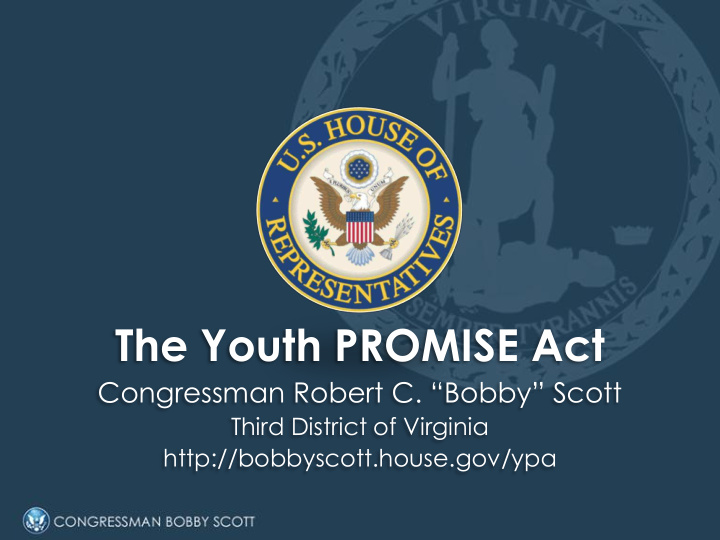



The Youth PROMISE Act Congressman Robert C. “Bobby” Scott Third District of Virginia http://bobbyscott.house.gov/ypa
U.S. Incarceration Rate Highest in the World Incarceration Rates per 100,000 People by Country* 4000 3748 3500 3000 2500 2207 2000 1500 1000 716 500 0 *Year of statistic varies by country according to most recent available data Sources: International Centre for Prison Studies , Prison Policy Initiative, The Sentencing Project, US Census, Bureau of Justice Statistics
U.S. Youth Incarceration Rate Highest in the World Incarceration Rates per 100,000 (Population Under 18) by Country 700 600 500 400 300 200 100 0 Sources: Figures for September 2002, taken from “Cross - national comparison of youth justice” (Youth Justice Board, 2008); “Reducing Youth Incarceration in the United States” (The Annie E. Casey Foundation, 2013) (Updated 03/06/14)
Prison Population Explosion is Relatively New U.S. State and Federal Prison Population, 1925-2013 1,800,000 1,600,000 1,400,000 1,200,000 1,000,000 800,000 600,000 400,000 200,000 0 Sources: Prison Policy Initiative, The Sentencing Project, Bureau of Justice Statistics. (09/18/14)
The War on Drugs Fueled Mass Incarceration Number of People in Prisons and Jails for Drug Offenses, 1980 and 2011 250,000 225,200 200,000 181,700 1980 150,000 2011 94,600 100,000 50,000 19,000 17,200 4,700 0 State Prisons Federal Prisons Jails Source: The Sentencing Project (09/18/14)
Outcomes for Black Males Age 26-30 Decline Sharply Since 1970 1970 100 High School 80 Graduates 60 High School Dropouts 40 20 0 Employed Not in Labor Force Jail Armed Forces 2000 70 60 High School 50 Graduates 40 High School 30 Dropouts 20 10 0 Employed Not in Labor Force Jail Armed Forces Source: Steven Raphael, “The Socioeconomic Status of Black Males: The Increasing Importance of Incarceration.” Goldman School of Public Policy, University of California, Berkeley, March 2004. (02/28/11)
Education Pays The More You Learn, The More You Earn Unemployment Rate vs. Educational Degree Attained Unemployment rate in 2013 Median Weekly Earnings in 2013 2.2 Doctoral Degree $1,623 Professional Degree 2.3 $1,714 Master's Degree 3.4 $1,329 Bachelor's Degree 4.0 $1,108 Associate Degree 5.4 $777 Some college 7.0 $727 High School Degree 7.5 $651 < High School $472 11.0 Source: Bureau of Labor Statistics, Current Population Survey. (8/7/2014)
The Youth PROMISE Act Model PHASE ONE: PLANNING • Locality convenes its stakeholders – What are we spending now? – Where should we target our services? • Strengths & Weaknesses Assessment • Creating the Plan – The continuum of evidence-based programs – Commitment to Re-Investment
The Youth PROMISE Act Model PHASE TWO: IMPLEMENTATION • Sustained investment over 3-6 years – Federal grants supplement, not supplant local efforts – Federal grants of up to $10 million/year • Clinical Evaluation • Fund Recapture to Keep Programs Running Federal Resources will be available in both phases to help localities choose evidence based programs and implement them effectively
Putting Money on the Table What if we reduced the African-American Incarceration rate to 500 per 100,000?* • Reduction from 2,252 per 100,000 to 500 per 100,000 • 1,752 fewer incarcerated x $29,000 year = $50,808,000 • Children per 100,000 = approx. 30,000 • $50,808,000 / 30,000 children = $1,693 /child/ year • $50,808,000 targeted at 1/3 of our most vulnerable children = $5,080 /child/ year * In the Pew Center on the States study “1 in 31”, it was determined that incarceration rates over 500 per 100,000 were counterproductive to reducing crime. Source : International Centre for Prison Studies, King’s College; Pew Center on the States. (2/28/11)
Putting Money on the Table What if we reduced the African- American Incarceration rate in the worst ten states to 500 per 100,000?* • Reduction from 3,748 per 100,000 to 500 per 100,000 • 3,248 fewer incarcerated x $29,000 year = $94,192,000 • Children per 100,000 = approx. 30,000 • $ 94,192,000 / 30,000 children = $3,140 /child /year • $ 94,192,000 targeted at 1/3 of our most vulnerable children = $9,419 /child /year * In the Pew Center on the States study “1 in 31”, it was determined that incarceration rates over 500 per 100,000 were counterproductive to reducing crime. Source : International Centre for Prison Studies, King’s College; Pew Center on the States. (2/28/11)
Recommend
More recommend